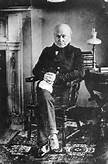Gagging the First Amendment
In the 1830s, Congress imposed a “gag rule” forbidding people from exercising their freedom by petitioning for the abolition of slavery.
The right to petition the federal government is guaranteed under the First Amendment to the U.S. Constitution. Americans had been requesting that Congress abolish slavery ever since Benjamin Franklin submitted the first petition shortly after the nation’s founding. Individual petitions had usually been voted upon and rejected. But when the American Anti-Slavery Society was founded in 1833, the number of petitions rapidly increased, and voting upon each one was no longer practical.
In March 1836, the Senate effectively violated the right to petition by invoking a rule under which senators would vote not on the petition itself, but whether to accept the petitions at all. The Senate then consistently voted to reject them. In the House of Representatives, Henry L. Pinckney of South Carolina proposed three resolutions regarding slavery:
Congress had no constitutional right to interfere with slavery in the states;
Congress “ought not” to interfere with slavery in the District of Columbia; and
Any petitions concerning the abolition of slavery would be “laid on the table” (i.e., rejected) by a subcommittee before being presented to the full House
The Pinckney Resolutions passed by a vote of 117 to 68, and they appeased slavery supporters for the time being. The third resolution became known as the “gag rule” because it sought to automatically gag or suppress any consideration of abolishing slavery. Gag rule supporters were mostly southern Democrats who argued that the founders did not intend for Congress to debate slavery. The gag rule was invoked at the beginning of every House session for nearly a decade.

U.S. Congressman John Quincy Adams
The greatest opponents of the gag rule were northern Whigs, among them former president and current Congressman John Quincy Adams of Massachusetts. Adams argued that the gag rule directly violated the First Amendment right “to petition the Government for a redress of grievances.” Adams’s passionate objections encouraged more people to join the antislavery crusade.
In 1840, the House passed the Twenty-First Rule, which expanded the gag rule by barring any petition regarding slavery from even being considered. Adams and his fellow Whigs stringently opposed this rule, and even some Democrats questioned the rule’s constitutionality. Two years later, abolitionist Congressman Joshua Giddings of Ohio was censured for violating the “gag rule” on the House floor. Giddings resigned his seat but was overwhelmingly reelected in the next House election.
Like most government actions, the result was the opposite of what was intended: rather than silencing petitioners, it motivated antislavery forces to lobby harder for abolition. The number of petitions was estimated at 34,000 before the gag rule, but it rose to 300,000 a year after the gag rule was first imposed, and then it rose to “uncountable” by the time the Twenty-First Rule was invoked. Adams finally managed to build a coalition of Whigs and Democrats that rescinded the gag rule in December 1844.
Not only was the gag rule unconstitutional, but it sharpened the differences between those supporting and opposing slavery.
Sources:
It’s Dangerous To Be Right When the Government is Wrong: The Case for Personal Freedom by Andrew P. Napolitano (Nashville, TN: Thomas Nelson, Inc., 2011)
The People’s Almanac edited by David Wallechinsky and Irving Wallace (Garden City, NY: Doubleday & Co., Inc., 1975)
http://www.answers.com/topic/gag-rule-antislavery
http://en.wikipedia.org/wiki/Gag_rule
http://blueandgraytrail.com/event/gag_rule





